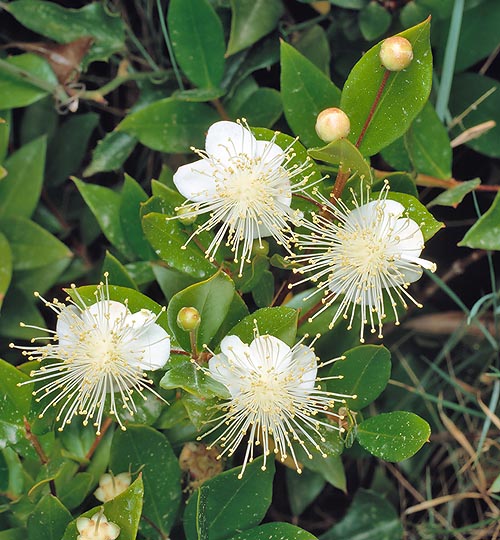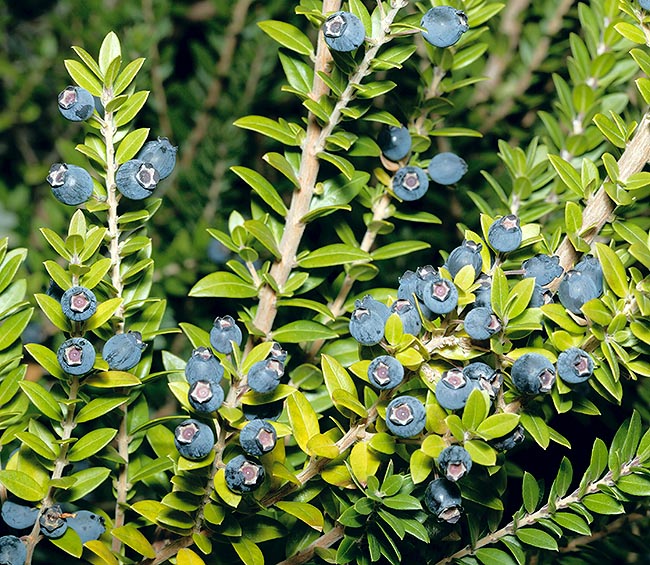Family : Myrtaceae

Text © Pietro Puccio

English translation by Mario Beltramini

Myrtus communis has 2-3 cm perfumed flowers with long white stamina © G. Mazza
The name of the genus comes from the Greek one “myrtos” of the common myrtle; the name of the species is the Latin term “communis” = common.
Common names: bridal myrtle, myrtle (English); myrte, myrte commun (French); myrtos (Greek); mirto, mortella (Italian); mirta, murta, murteira (Portuguese); arrayán, mirta, mirto, mortera, murta, murtera (Spanish); Brautmyrte, Myrte (German); rihan, mersin (Arabic); tarihant, chilmoun (Berber); morta, mortula (Corsican); nertha, nerthe, nerto (Occitan).
The Myrtus communis L. (1753) is a shrub or a small evergreen tree quite variable, ramified, tall up to about 3 m, even if specimens in the wild may reach the 5 m, with ascending branches with a reddish bark, which, with the time, tends to the grey and the thick foliage.
The leaves are simple, entire, opposite, usually sessile (without petiole), ovate-lanceolate with sharp apex, 2,5-5 cm long, coriaceous, of intense glossy green colour on the upper page, opaque pale green below, superficially speckled by oleiferous glands, visible in transparency, which render them particularly aromatic when crumpled.
In summer, the flowers, on a short peduncle, are axillary, solitary, hermaphrodite, of 2-3 cm of diameter, fragrant, with 5 triangular sepals, 1-2 mm long, 5 obovate petals, 6-15 mm long, white or pinkish, and numerous white stamina little longer than the petals. The fruits are fleshy, ellipsoid berries, 1,2-1,4 cm long and of about 0,7 cm of diameter, of blackish blue-purple when ripe, containing whitish reniform seeds, 2,5-3 mm long; there is also a variety with white fruits.
It reproduces by seed, air layering and semi-woody cutting in summer. Rather slow-growing species, typical of the Mediterranean area, it is cultivable in full sun or slight shade on soils of various nature, even if preferring those rather sandy, neutral or alkaline, well drained; it bears the saltiness, the high temperatures, and, well rooted, periods of drought. It is fairly resistant to the low temperatures, as it may resist up to about -6 °C and, if well sheltered, to -9 °C, but with damage to the foliage.

The berries are edible and the aromatic leaves are used in cooking. Medical properties © Giuseppe Mazza
The berries are edible and in Sardinia, where the plant is particularly common in the wild, they are employed for preparing the famous liqueur, the “Mirto”; the leaves, fresh as well as dried, are utilized in the Mediterranean cuisine and the wood for aromatizing, by means of smoking, many local specialities, in particular in Italy. The wood, of good quality, hard, compact and fine-grained, is utilized for tools, sticks and furniture; it is also excellent as firewood.
Leaves and berries are employed in the traditional medicine for their antioxidant, astringent, antiseptic and expectorant properties; they contain tannins (14%) and essential oil (0,3-06%), formed mainly by myrtenol, cineol, alpha-Pinene, mirtenil acetate, and geraniol. The essential oil extracted from the leaves is also utilized in the food industry, for aromatizing sauces and drinks, and in the pharmaceutical and cosmetic ones too. The myrtle has had an important role in the culture and traditions of the countries of the Mediterranean area, in particular, Greece and Italy.
Two subspecies are recognized: Myrtus communis subsp. communis, described before, and Myrtus communis subsp. tarentina (L.) Nyman (1879), which differs for the contained height, less than 2 m, the close leaves not longer than 2 cm and the globose fruits, particularly suitable for low borders, as soil cover and in the topiary art.
Synonyms of Myrtus communis subsp. communis: Myrtus major Garsault (1764); Myrtus minor Garsault (1764); Myrtus acuta Mill. (1768); Myrtus baetica (L.) Mill. (1768); Myrtus belgica (L.) Mill. (1768); Myrtus italica Mill. (1768); Myrtus minima Mill. (1768); Myrtus littoralis Salisb. (1796); Myrtus macrophylla J.St.-Hil. (1803); Myrtus microphylla J.St.-Hil. (1803); Myrtus romanifolia J.St.-Hil. (1803); Myrtus romana (L.) Hoffmanns. (1824); Myrtus buxifolia Raf. (1838); Myrtus lanceolata Raf. (1838); Myrtus latifolia Raf. (1838); Myrtus borbonis Sennen (1923); Myrtus media Hoffmanns. (1824); Myrtus angustifolia Raf. (1838); Myrtus oerstedeana O.Berg (1856); Myrtus sparsifolia O.Berg (1856); Myrtus veneris Bubani (1899); Myrtus acutifolia (L.) Sennen & Teodoro (1929); Myrtus augustinii Sennen & Teodoro (1929); Myrtus baui Sennen & Teodoro (1929); Myrtus briquetii (Sennen & Teodoro) Sennen & Teodoro (1929); Myrtus christinae (Sennen & Teodoro) Sennen & Teodoro (1929); Myrtus eusebii (Sennen & Teodoro) Sennen & Teodoro (1929); Myrtus gervasii (Sennen & Teodoro) Sennen & Teodoro (1929); Myrtus josephi Sennen & Teodoro (1929); Myrtus mirifolia Sennen & Teodoro (1929); Myrtus petri-ludovici (Sennen & Teodoro) Sennen & Teodoro (1929); Myrtus rodesi Sennen & Teodoro (1929); Myrtus theodori Sennen (1929); Myrtus vidalii (Sennen & Teodoro) Sennen & Teodoro (1929).
Synonyms of Myrtus communis subsp. tarentina: Myrtus communis var. tarentina L. (1753); Myrtus tarentina (L.) Mill. (1768).
→ To appreciate the biodiversity within MYRTACEAE family please click here.
